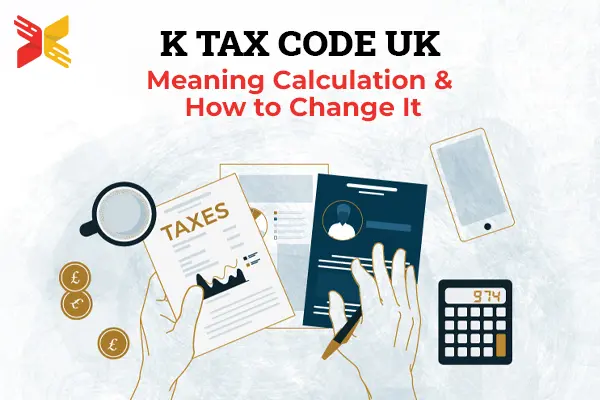What Does a K Tax Code Mean?
A K tax code is a unique tax code used in the UK when a person has taxable benefits that exceed their allowance. This tax code indicates that the untouched income of an employee is more than the tax-free amount they deserve. Instead of providing an allowance, the tax code increases the UK taxable income, causing a high tax deduction.

Most employees have a standard tax code, meaning that they benefit from tax-free income to a certain extent. However, a K code is applied when the deductions, such as the benefits, unpaid taxes, or state pension, are higher than this limit. This article checks the tax code list, how it functions, why it is assigned, and how it compares to other UK tax codes.
How Does a K Tax Code Work in the UK?
A K tax code in the UK means you have income that isn’t being taxed elsewhere and is above your allowance. This can happen when you have taxable benefits like a company car or state pension and your total untaxed income is above your allowance. Instead of giving you extra tax-free income, a K code increases your taxable earnings so the right amount of tax is deducted. The number in the K code is the amount of extra income that needs to be added to your salary for tax purposes. For example, a K475 code means an extra £4,750 is added to your salary for tax.
Employers use the K tax code to adjust PAYE deductions so HMRC can recover the tax owed. However, an employer can’t deduct more than 50% of an employee’s pre-tax earnings even with a K tax code. These codes are often used when previous underpayments need to be collected or when benefits put someone’s taxable income above their allowance. If an employee thinks their K tax code is wrong they should contact HMRC to review their tax situation and ask for changes if needed.
| Tax Code | Effect on Taxable Income | Who Receives It? |
|---|---|---|
| Standard Tax Code (e.g., 1257L) | Personal allowance deducted | Most employees |
| K Tax Code (e.g., K300) | Additional taxable amount added | Employees with large taxable benefits |
| BR Tax Code | Tax at the basic rate on all earnings | Second job or pension |
The K tax code checker helps employees verify if their tax code is accurate. HMRC provides tax code details on payslips, so checking regularly can prevent unexpected tax bills.
Why Have I Been Assigned a K Tax Code?
A K tax code is applied when deductions from an individual’s income, such as unpaid tax or taxable benefits, exceed their tax-free allowance. This means the employer or pension provider will need to collect extra tax through PAYE. HMRC applies a K tax code to ensure the right amount of tax is deducted when other sources of income or benefits affect an individual’s allowance. For example, if someone has company benefits like a car or underpaid tax from previous years, HMRC will apply a K tax code to balance the tax liability.
To check if you have the right K tax code, use the official tax code checker from HMRC. If you think the K tax code HMRC applied is wrong, you can contact them to have it reviewed. An example of a K tax code could be K100, which means an additional £10,000 of taxable income is added to your pay for tax purposes. Since tax code K reduces the tax-free allowance, it will result in more deductions. If you’re not sure why you have this code, check your PAYE notice or P60 to find out more.
Can I Change My K Tax Code?
An employee can request a tax code change if they believe their K tax code HMRC is incorrect. The following steps help determine whether a change is necessary:
- Check Payslips and Tax Code Notices
Using a tax code checker, employees can verify whether the deductions align with their taxable benefits. - Contact HMRC
If the tax code is incorrect, employees should contact HMRC via their online account or helpline. They may need to provide details of earnings, benefits, and taxes paid. - Request an Updated Code from an Employer
If HMRC confirms an adjustment, it sends the employer an updated tax code, ensuring correct tax deductions. - Use the K Tax Code Calculator
A K tax code calculator helps estimate whether the assigned tax code correctly reflects an individual’s tax situation.
If an employee successfully updates their K tax code, for example, their tax deductions may decrease, increasing their take-home pay.
How Does the K Tax Code Compare to Other UK Tax Codes?
The K tax code in the UK is different from most other tax codes as it means you have taxable benefits or unpaid tax that exceeds your tax-free allowance. Unlike tax codes like 1257L, which allow most people to earn a certain amount before paying tax, the K tax code reduces your tax-free allowance to zero and adds the excess to your taxable income. This code usually applies to those with high employer benefits, state pensions above the personal allowance, or outstanding tax debts collected through PAYE. So if you have a K tax code you may see more deductions from your salary than those with standard tax codes like 1257L or emergency tax codes like BR and OT tax codes.
Whereas other UK tax codes, like the BR tax code or the D0 tax code, apply a flat rate to income. The BR tax code taxes all income at 20% and is often used when someone has multiple jobs or pensions. The D0 tax code applies 40% to all income under that employment. The K tax code is different as it adds a negative personal allowance to the taxable income rather than a flat percentage. This can result in much higher tax deductions, especially for those with large taxable benefits. Understanding these differences is key, as tax codes determine how much HMRC deducts from wages or pensions and affects take-home pay.
How Can I Check My K Tax Code and Avoid Errors?
Check your K tax code UK regularly to avoid overpayments or surprise tax bills. Here’s how to check your tax code is correct:
- Payslips
Tax codes are on your payslips, showing how much is being taxed. - Tax Code Checker
HMRC has an online tax code checker for you to check your tax code. - K Tax Code Calculator
A K tax code calculator will tell you if tax deductions match your expectations. - Contact HMRC for help
If you think there’s an error, get in touch with HMRC to sort it out.
Conclusion
A K tax code UK indicates that an employee’s taxable deductions exceed their allowance. This often results from company benefits, unpaid tax, or pension income. Unlike a standard tax code 24/25, which allows tax-free earnings, a K tax code HMRC increases taxable income. Employees should use a tax code checker to verify accuracy and seek adjustments if necessary.
If assigned a K tax code example, understanding its implications can help manage tax payments effectively. Comparing it with other tax codes, such as the BR tax code, highlights the differences in taxation methods. Employees can use a K tax code calculator to ensure correct tax payments and avoid unnecessary deductions.
FAQs
1. How does a K tax code differ from a BR tax code?
A K tax code is assigned when an employee’s taxable deductions exceed their allowance, increasing the amount of taxable income. In contrast, a tax code BR applies a flat 20% tax rate on all earnings, usually for individuals with multiple jobs or pensions.
2. Can my K tax code change if there are tax code updates?
Yes, tax codes can change when HMRC updates tax rules or personal financial circumstances shift. Checking tax code new updates each financial year helps employees ensure their tax deductions are correct. If your tax code is incorrect, you can contact HMRC to request an adjustment.
3. How do I know if my K tax code is correct?
You can verify your K tax code by checking your payslip, using a tax code checker, or reviewing tax code new updates from HMRC. If your deductions seem too high, using a K tax code calculator can help estimate whether your tax code aligns with your taxable income.
















